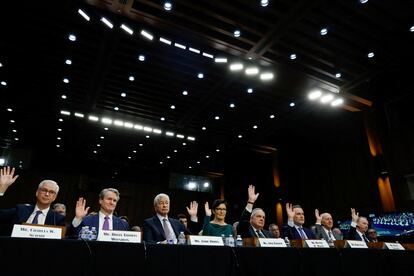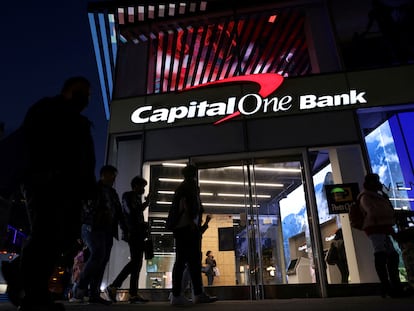The payment of more interest on deposits hurts the bottom line of large US banks
The profit of the six main entities falls 3% in the first quarter despite the improvement in the investment banking business


Wall Street’s large banks are feeling the effects of the sharp rise in interest rates at two different speeds. On one hand, they hastily passed on the hikes on their loans, but they dragged their feet when it came to deposits and other interest-paying products. Now, expenses derived from high interest expenses are skyrocketing and affecting first quarter earnings results. Large banks have not particularly suffered from the rise in commercial real estate delinquencies, which puts more pressure on regional banks. Instead, they have had to make new contributions to the Federal Deposit Insurance Commission (FDIC) to finance the bailouts of Silicon Valley Bank and the rest of the mid-sized banks that failed last year. Meanwhile, investment banking commissions are recovering in the heat of the resurgence of IPOs, bond placements and corporate operations.
JPMorgan, Bank of America, Morgan Stanley, Citi, Goldman Sachs and Wells Fargo made profits of $34.4 billion in the first three months of this year, 3% less than a year before. The largest bank in the United States, JPMorgan, continues to be the driver of results, earning $13.4 billion, 6% more than in the first quarter of 2023, but this increase was mainly due to the incorporation of First Republic Bank, which it bought at a bargain price last year. Without this operation, its profit would only have grown by 1%.
The president of JPMorgan, Jamie Dimon, spoke of a “normalization” of the interest margin and the cost of credit, which translates into a smaller difference between what the bank charges for loans and what it pays for deposits and other interest-paying products. The first quarter accounts reflect that interest income still grew by 28% year-on-year (partly due to higher volumes derived from the incorporation of First Republic Bank), but what is new is that interest expenses shot up by 49%. Furthermore, when quarters are compared sequentially, net interest income falls from the fourth quarter of last year to the first quarter of this year.
That normalization, Dimon said, will continue as clients move from non-interest-paying deposits to products with higher rates. The bank’s chief financial officer, Jeremy Barnum, explained it in the conference with analysts: “We don’t think it makes sense to assume that in a world where checking and savings accounts are paying zero and the official interest rate is above 5% we are not going to see continuous migration,” he said.
The same effect is more noticeable in Wells Fargo. Its interest income grew 18% to $22.84 billion, but interest expenses soared 76% to $10.2 billion. The lender attributes this to the impact of rising interest rates on financing costs, including the impact of customers migrating to higher-profit deposit products. With this, the interest margin was reduced by 8%, $12.2 billion, weighing down the income statement despite the improvement in commission income. Attributable consolidated profits also fell 8%, to $4.3 billion.
The same happened with Bank of America, the second-largest bank in the United States. With a similar volume of deposits, interest expenses grew from $4.3 billion to $9.1 billion in one year. As a whole, higher payments on deposits and other products weighed down the interest margin and contributed to a 20% drop in profit, to $6.1 billion.
Citi suffered a 27% decline in profit. The group’s accounts were are also affected by pressure on the interest margin, but not as much. The lender is going through its own restructuring and transition process, with severance expenses due to workforce reduction and lower income from the sale of businesses. Along with this, provisions for credit losses are growing strongly.
Improve investment banking
After a dark period for the investment banking business, income from fees and profits are recovering. IPO activity has picked up and debt issuances have also skyrocketed, breathing new life into the accounts of Wall Street giants. Income from investment banking fees soared by 30%.
This has especially benefited Goldman Sachs and Morgan Stanley, which are most dependent on that line of business. Goldman stands out in commissions for placement and underwriting of share issues, where income soared 45%, to $370 million; income from debt issues rose 38% to $699 million, and advisory fees rose 24% to just over $1 million.
Thanks to investment banking and trader activity, Goldman Sachs’ profit shot up 27% in the first quarter to $3.9 billion, surpassing Citi. In their case, the interest margin dropped, but this has little weight in their business.
The same goes for Morgan Stanley, whose profit grew by 15% to $3.2 billion due to the 16% increase in its investment banking income and the good evolution of the brokerage and wealth management lines.
Goldman surpassed JPMorgan in investment banking fees, which brought in $2 billion, 21% more than the previous year. This was especially due to the increase in commissions for debt issues, which shot up 58% to $1 billion. Shares also surged 51%, to $355 million, while advisory services fell sharply by 21%, to $598 million.
Bank of America breaks down commissions differently, but it grows in all chapters, especially in issues. Altogether, investment banking fees increased by 35% to $1.6 billion. In the case of Citi, the trends are similar. Commissions on fixed-income and variable-income placements grew by around 60%, while insurance commissions fell by 17%. Overall, its investment banking fees rose 32% to $977 million. At Wells Fargo, investment banking fees soared 92%, to $627 million. The bank seeks to grow in that business, in which it is still relatively small.
Bailout bill
Banks continue to foot the bill for the 2023 bailouts of Silicon Valley Bank, Signature Bank and First Republic Bank. After the extraordinary provisions that battered their accounts at the end of 2023, lenders have had to provision new contributions again.
In the case of JPMorgan, the additional amount has been $725 million and in Bank of America, about $700 million. Wells Fargo has had to allocate $284 million, while Citi has reserved an additional $251 million. Goldman Sachs and Morgan Stanley, which have a smaller balance sheet and fewer guaranteed deposits, have only had to contribute an additional $78 and $42 million, respectively.
Sign up for our weekly newsletter to get more English-language news coverage from EL PAÍS USA Edition
Tu suscripción se está usando en otro dispositivo
¿Quieres añadir otro usuario a tu suscripción?
Si continúas leyendo en este dispositivo, no se podrá leer en el otro.
FlechaTu suscripción se está usando en otro dispositivo y solo puedes acceder a EL PAÍS desde un dispositivo a la vez.
Si quieres compartir tu cuenta, cambia tu suscripción a la modalidad Premium, así podrás añadir otro usuario. Cada uno accederá con su propia cuenta de email, lo que os permitirá personalizar vuestra experiencia en EL PAÍS.
¿Tienes una suscripción de empresa? Accede aquí para contratar más cuentas.
En el caso de no saber quién está usando tu cuenta, te recomendamos cambiar tu contraseña aquí.
Si decides continuar compartiendo tu cuenta, este mensaje se mostrará en tu dispositivo y en el de la otra persona que está usando tu cuenta de forma indefinida, afectando a tu experiencia de lectura. Puedes consultar aquí los términos y condiciones de la suscripción digital.
More information
Archived In
Últimas noticias
There is as much life left to discover on planet Earth as that which is already known
Dozens presumed dead, around 100 injured in fire at Swiss Alps bar during New Year’s celebration
Is porn for women different from conventional porn? We spoke to those who make it
Cartagena de Indias is sinking: What can the city do to mitigate it?
Most viewed
- Sinaloa Cartel war is taking its toll on Los Chapitos
- Reinhard Genzel, Nobel laureate in physics: ‘One-minute videos will never give you the truth’
- Oona Chaplin: ‘I told James Cameron that I was living in a treehouse and starting a permaculture project with a friend’
- David King, chemist: ‘There are scientists studying how to cool the planet; nobody should stop these experiments from happening’
- Why the price of coffee has skyrocketed: from Brazilian plantations to specialty coffee houses










































